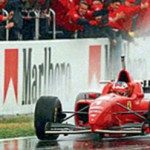The Mighty Cosworth DFV and its Sunset
- This topic has 5 replies, 4 voices, and was last updated 13 years, 2 months ago by
Anonymous.
- AuthorPosts
- 21st February 2011, 16:56 at 4:56 pm #128947
Anonymous
InactiveGreetings guys, I’m new on this forum and I look forward to change a few words with you regarding our beloved wheel sport.
Yesterday I was taking a look back in time and I was thinking:
The Cosworth DFV was a superb powerplant, from 1968 until 1983 we saw a massive dominance on the F1, no doubt about that.
But what makes me wonder is, why (at least look like that) Cosworth relied its supply only on the DFVs and they did not want to enter the Turbo challenge that was about to come from 1984 to 1988.
Does any of you guys feel the same way? I mean, Cosworth only wanting to make quick money and not developing a Turbo solution for its customers ? Or it is just myself ?
21st February 2011, 17:18 at 5:18 pm #162037 AsanatorParticipant
AsanatorParticipantIn 1986 Cosworth Supplied Haas Lola with a 1.5l V6 Turbo.
In 1987 it supplied a 1.5l V6 turbo to Benneton which allegedly generated over 1000BHP in quali spec
21st February 2011, 17:21 at 5:21 pm #162038 AsanatorParticipant
AsanatorParticipantOpps, Benetton!
22nd February 2011, 9:23 at 9:23 am #162039TimG
ParticipantCosworth simply weren’t keen on the turbo movement. Keith Duckworth (the ‘worth’ in Cosworth) was once quoted as saying about Renault’s fledgling turbo efforts that “it’ll never bloody work and if it does it should be banned.”
The company was simply too slow to see what was coming. It wasn’t alone in this respect, the likes of Williams and especially Tyrrell were both well behind the curve on this in contrast to the likes of Renault, Ferrari and McLaren. Consider also that the turbo era also saw the start of the rise of the manufacturers in F1 with Renault, BMW and Honda all entering the sport in the late 1970s/early 1980s. Cosworth simply couldn’t compete without support from Ford, who were never very good at exploiting the marketing potential of their involvement in F1.
Developing a fully competitive, reliable turbo engine took time, as shown by Honda, BMW and Renault’s early experiences. Cosworth introduced its own turbo engine for 1986 which was powerful but unreliable and thirsty compared with Honda’s much more refined V6. But by then moves were already underway to restrict the turbos and an outright ban from 1989 was announced at the end of ’86. So there seemed to be little point in spending good money to develop an engine that was shortly to be obsolete anyway.
Cosworth kept the turbo engine for 1987 but dropped it for 1988 when, wrongly as it transpired, it was assumed that normally aspirated engines would have the edge over the increasingly fuel and boost-restricted turbos. So Cosworth went back to the DFV which (badged as the DFR) competed in F1 until the end of 1991, although works team Benetton had access to the new HB from 1989.
22nd February 2011, 15:22 at 3:22 pm #162040Anonymous
InactiveLoved the answer TimG…clear and straightforward…I always wondered WHY Cosworth seemed to be stuck in Time (DFV)…and it gives me the answer…thanks
24th February 2011, 9:12 at 9:12 am #162041Anonymous
InactiveNice post TIMG
Comments I would add is that.
1: The DFV got a new lease of life with the skirted ground effect cars, due to its more compact dimensions compared with the F12, V12 and turbo’s allowing better aerodynamic packaging.
2: Cosworth problem in part was their success, the DFV was also basis for not only a successful business supplying the independant F1 teams, but also for Indy Car, endurance racing, power boats etc. It was simply had too much too loose in betting the business on an expensive Turbo development programme, until Ford provided the cash.
- AuthorPosts
- You must be logged in to reply to this topic.



